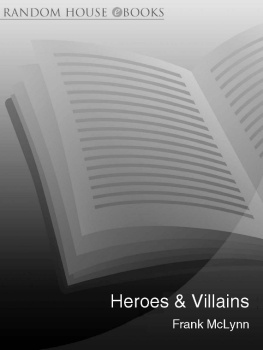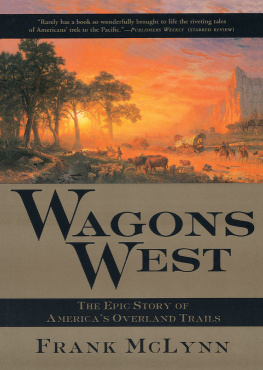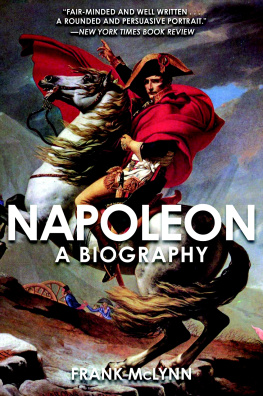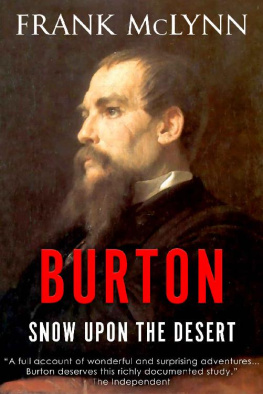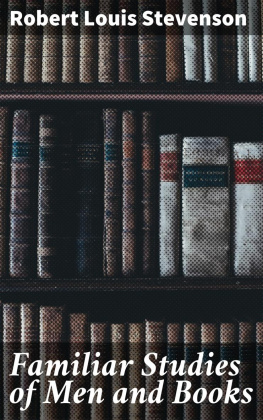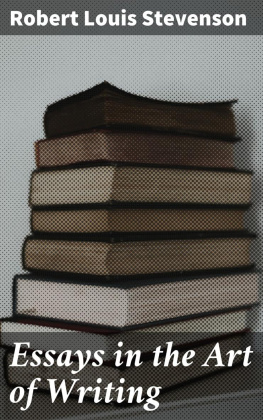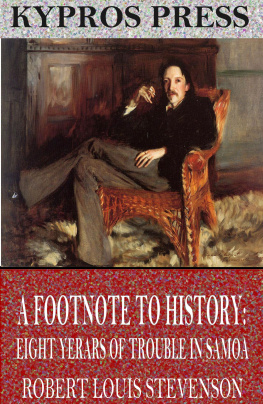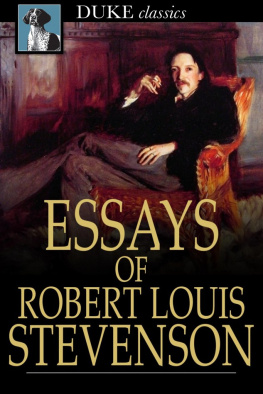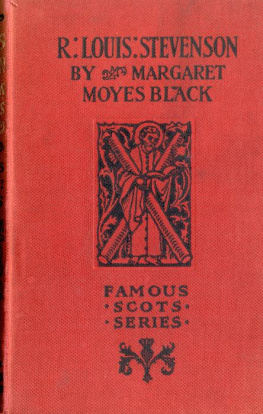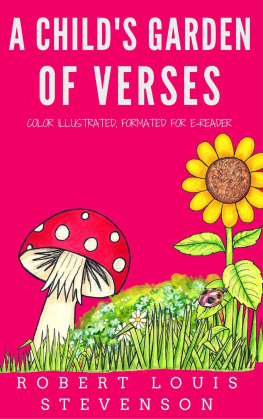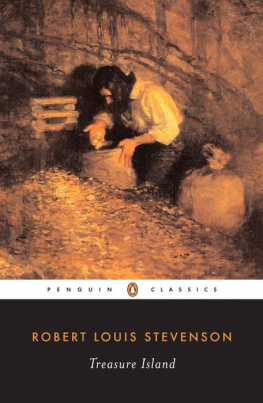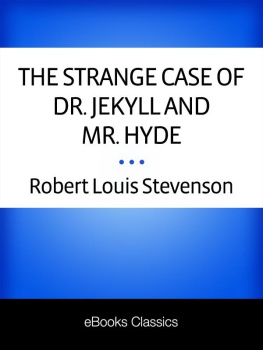Frank McLynn - Robert Louis Stevenson
Here you can read online Frank McLynn - Robert Louis Stevenson full text of the book (entire story) in english for free. Download pdf and epub, get meaning, cover and reviews about this ebook. year: 1994, publisher: Random House, genre: Non-fiction. Description of the work, (preface) as well as reviews are available. Best literature library LitArk.com created for fans of good reading and offers a wide selection of genres:
Romance novel
Science fiction
Adventure
Detective
Science
History
Home and family
Prose
Art
Politics
Computer
Non-fiction
Religion
Business
Children
Humor
Choose a favorite category and find really read worthwhile books. Enjoy immersion in the world of imagination, feel the emotions of the characters or learn something new for yourself, make an fascinating discovery.
- Book:Robert Louis Stevenson
- Author:
- Publisher:Random House
- Genre:
- Year:1994
- Rating:5 / 5
- Favourites:Add to favourites
- Your mark:
- 100
- 1
- 2
- 3
- 4
- 5
Robert Louis Stevenson: summary, description and annotation
We offer to read an annotation, description, summary or preface (depends on what the author of the book "Robert Louis Stevenson" wrote himself). If you haven't found the necessary information about the book — write in the comments, we will try to find it.
Robert Louis Stevenson — read online for free the complete book (whole text) full work
Below is the text of the book, divided by pages. System saving the place of the last page read, allows you to conveniently read the book "Robert Louis Stevenson" online for free, without having to search again every time where you left off. Put a bookmark, and you can go to the page where you finished reading at any time.
Font size:
Interval:
Bookmark:
Contents
Frank McLynn was educated at Wadham College, Oxford, and the University of London. He was Alistair Horne Research Fellow at St Antonys College, Oxford, in 198788, and now works as a full-time writer. He is the author of biographies of H. M. Stanley and Richard Burton, as well as several books relating to the Jacobite movement, including Charles Edward Stuart, which was shortlisted for the 1989 McVities Prize for Scottish Writer of the Year, and The Jacobite Army in England, which won the 1985 Cheltenham Prize for Literature. His most recent books are Hearts of Darkness: The European Exploration of Africa (also available in Pimlico) and Fitzroy Maclean.
A sensual Calvinist, a Tory radical, a consumptive celebrant of action, a passionate Scot who chose to live anywhere but Scotland. Not for nothing was Robert Louis Stevenson the author of Dr Jekyll and Mr Hyde.
The greatest of Scottish novelists, Stevenson lived a life as extraordinary and as absorbing as his books. But it was a life tormented by an autocratic father, recurring illness, the prudery of the Victorian reading public and, most of all, the stresses imposed on him by his wife and stepchildren.
This powerful new study is published to mark the centenery of Stevensons death at the age of forty-four.
Thomas Stevenson, Louiss father
Margaret Stevenson, his mother
Margaret Stevenson with Louis, 1854
Louis (right), aged 8, with his cousin, Bob
Alison Cunningham (Cummy) in later life
The Stevenson family with Cummy (right) and two maids
Charles Robinsons design for Windy Nights in A Childs Garden of Verses
Edinburgh: The Lawnmarket, looking towards St Giles
Edinburgh: The shop on the corner of Leith Walk and Antigua Street where Louis bought stationery
Walter Cranes frontispiece illustration for Travels with a Donkey
RLS, aged 28. Etching by Wingman after a drawing by Fanny Stevenson
Sirons inn at Barbizon. A photograph taken in the 1870s
RLS. A portrait inscribed To CB (Charles Baxter)
17 Heriot Row
A letter to W.E.Henley
RLS. A portrait by Hawker of Bournemouth
Fanny Osbourne in 1880 before her marriage to RLS
RLS at Davos
Woodcut designed by Joe Strong for the frontispiece of The Silverado Squatters showing Louis and Fanny in their shack
Saranac Lake, New York State, 188788; (from left) Valentine, the French maid; a local help; Lloyd Osbourne; Fanny, RLS
Lloyd Osbourne, aged 20, in 1888
The schooner Casco off Vancouver
The Stevensons being entertained by King Kalakaua and his sister, Princess Liliuokalani, in Honolulu
RLS with Fanny and a missionary priest. A photograph taken by Lloyd Osbourne
At Sans Souci, Butaritari
The SS Janet Nicholl
RLS with Kalakaua (right), Fanny (left), his mother and Lloyd on board the Casco
The house at Vailima, Samoa
Family and servants, Vailima, 31 July 1892; with RLS are Joe Strong (with parrot); Mary, the Australian maid; Margaret Stevenson; Lloyd Osbourne; Fanny; Belle Strong and her son, Austin
RLS in Samoa
RLS dictating to Belle at Vailima, 1892
RLS with Fanny, Belle and members of his household on the verandah at Vailima
RLS playing his flageolet in bed at Vailima
RLS lying in state
Bas relief medallion by Augustus St Gaudens
RLSs tomb on Mt Vaea, Samoa
Photographic Acknowledgements
British Library 19; Edinburgh City Museums Lady Stairs House: 110, 1218, 2029, 31, 33, 34, 36; Mansell Collection: 11, 30, 32, 35.
This book has been written in the firm conviction that Robert Louis Stevenson is Scotlands greatest writer of English prose. It is usual to regard Sir Walter Scott as the man to whom this title is due, and it is true that, in terms of achievement, Scott takes the palm. Achievement and natural giftedness are, however, very different qualities: one may take the example of the two great Soviet composers Shostakovich and Prokofiev, of whom the formers achievement was more impressive but the latters intrinsic genius was greater. So it seems to me to be with Scott and Stevenson, and this truth has often been obscured by those who talk of Scott as Stevensons literary father. I am wholeheartedly behind Gerard Manley Hopkins, who told Robert Bridges: I think that Robert Lewis (sic) Stevenson shows more genius in a page than Scott in a volume. With Scott history and politics were always primary, storytelling secondary; with Stevenson it was the reverse, and perhaps this is why Kidnapped, Catriona and The Master of Ballantrae, despite their seemingly antiquarian Jacobite point of departure, still live today, while Waverley and Redgauntlet, for all their merits, have the musty smell of the historical museum. Scott has a ponderousness that sometimes touches depths of tragic profundity, but Stevenson is a shrewder judge of human nature, has a better sense of irony and humour and, above all, is a deeper psychologist and a more modern figure in his appreciation of the multiple ambiguities of the universe. Moreover, if ones taste runs to economy rather than prolixity, Stevenson will always win over Scott. Nothing in Scott is so tersely effective in the true Scottish idiom as Alan Brecks description of James More in Catriona: The mans as boss as a drum; hes just a wame and a wheen words.
One hundred years after his death, it seems that time has not been kind to Stevenson. Immediately after his death, his family and friends set to work to fashion the legend of RLS one of the few writers instantly familiar from his initials alone. Works of hagiography turned him into a Christ-figure in the true sense, combining the earthly sufferings of Jesus with the divine status of a son of God; in accounts like Graham Balfours authorised biography of 1901, his wife and her children played the role of ministering archangels. Arthur Quiller-Couch absurdly placed him in the same company as Shakespeare, Milton, Keats and Dickens: Surely another age will wonder over this curiosity of letters that for five years the needle of literary endeavour in Great Britain has quivered towards a little island in the South Pacific, as to its magnetic pole... Put away books and paper and pen... Stevenson is dead, and now there is nobody left to write for. The reaction to this nonsense, when it came in the 1920s, was severe. Biographers like Steuart and Hellman first revealed the feet of clay of his wife, Fanny, and for this service have never ceased to be reviled by a certain faction of RLS-lovers. More seriously, Stevensons own reputation as writer attracted the critical scalpel, and excerpts from three different adverse critics of the 1920s shows just how far the critical pendulum swung.
Frank Swinnerton, in the first great debunking book of criticism in 1924, accused Stevenson of being the literary equivalent of a singer who cannot hold a note: there were great moments in the Stevenson oeuvre, he claimed, but they were merely brilliant pieces in an indifferently executed mosaic, and it was because he had no central sustaining vision that RLS could never scale the heights of a Jane Austen, a Balzac or even an Alexandre Dumas pre: It was because they offered no new effects that The Great North Road and Heathercat and The Young Chevalier dried suddenly upon his pen, dead before ever they were begun... he could not make romance out of chopped hay, such as The Young Chevalier, with its bald, hopeless attempts to galvanise the Master into life again.
Next pageFont size:
Interval:
Bookmark:
Similar books «Robert Louis Stevenson»
Look at similar books to Robert Louis Stevenson. We have selected literature similar in name and meaning in the hope of providing readers with more options to find new, interesting, not yet read works.
Discussion, reviews of the book Robert Louis Stevenson and just readers' own opinions. Leave your comments, write what you think about the work, its meaning or the main characters. Specify what exactly you liked and what you didn't like, and why you think so.


